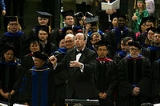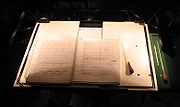
Director of Bands
Encyclopedia
A Director of Bands is the head figure of a marching or concert form of bands, a person who leads a musical ensemble. The Director, by history and tradition, must know all the concepts of music and must be able to teach all different kinds of instrumental musicians in order to make a performance at a certain dateline before the scheduled performance.

An understanding of the basic elements of musical expression (tempo
, dynamics
, articulation
) and the ability to communicate them effectively to an ensemble is necessary in order to conduct. The ability to communicate nuances of phrasing and expression through gesture is also beneficial. Conducting gestures may be choreographed beforehand by the conductor while studying the score
, or may be spontaneous.
A distinction is sometimes made between orchestral conducting and choral conducting. Stereotypically
, orchestral conductors use a baton
more often than choral conductors (though not always: this is up to the conductor's personal preference), and favor the use of beat patterns over gestural conducting, which concentrates more on musical expression and shape.
The grip of the baton
is a contentious issue that varies from conductor to conductor. Despite a wide variety of styles, a number of standard conventions have developed.

Education
Most students attend a four year university to earn a Bachelor Degree in Music. Degrees earned after a Bachelor's is a Masters in Music and a Doctoral Degree in Music. The ones that earn a Doctoral in Music usually seek to become a professor at an institution of higher learning.Conducting techniques
Conducting is a means of communicating real-time information to performers. There are no absolute rules on how to conduct correctly, and a wide variety of different conducting styles exist. The primary responsibilities of the conductor are to set the tempo, execute clear preparations and beats, and to listen and shape the sound of the ensemble.An understanding of the basic elements of musical expression (tempo
Tempo
In musical terminology, tempo is the speed or pace of a given piece. Tempo is a crucial element of any musical composition, as it can affect the mood and difficulty of a piece.-Measuring tempo:...
, dynamics
Dynamics (music)
In music, dynamics normally refers to the volume of a sound or note, but can also refer to every aspect of the execution of a given piece, either stylistic or functional . The term is also applied to the written or printed musical notation used to indicate dynamics...
, articulation
Articulation (music)
In music, articulation refers to the musical direction performance technique which affects the transition or continuity on a single note or between multiple notes or sounds.- Types of articulations :...
) and the ability to communicate them effectively to an ensemble is necessary in order to conduct. The ability to communicate nuances of phrasing and expression through gesture is also beneficial. Conducting gestures may be choreographed beforehand by the conductor while studying the score
Sheet music
Sheet music is a hand-written or printed form of music notation that uses modern musical symbols; like its analogs—books, pamphlets, etc.—the medium of sheet music typically is paper , although the access to musical notation in recent years includes also presentation on computer screens...
, or may be spontaneous.
A distinction is sometimes made between orchestral conducting and choral conducting. Stereotypically
Stereotype
A stereotype is a popular belief about specific social groups or types of individuals. The concepts of "stereotype" and "prejudice" are often confused with many other different meanings...
, orchestral conductors use a baton
Baton (conducting)
A baton is a stick that is used by conductors primarily to exaggerate and enhance the manual and bodily movements associated with directing an ensemble of musicians. They are generally made of a light wood, fiberglass or carbon fiber which is tapered to a grip shaped like a pear, drop, cylinder...
more often than choral conductors (though not always: this is up to the conductor's personal preference), and favor the use of beat patterns over gestural conducting, which concentrates more on musical expression and shape.
The grip of the baton
Baton (conducting)
A baton is a stick that is used by conductors primarily to exaggerate and enhance the manual and bodily movements associated with directing an ensemble of musicians. They are generally made of a light wood, fiberglass or carbon fiber which is tapered to a grip shaped like a pear, drop, cylinder...
is a contentious issue that varies from conductor to conductor. Despite a wide variety of styles, a number of standard conventions have developed.

